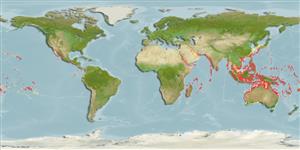Common names from other countries
Environment: milieu / climate zone / depth range / distribution range
Écologie
; profondeur 1 - 50 m (Ref. 100964). Tropical
Indo-Pacific. The form occurring from the Red Sea to the Gulf of Oman is usually distinguished under the name Cerithium erythraeonense.
Length at first maturity / Taille / Poids / Âge
Maturity: Lm ? range ? - ? cm Max length : 15.0 cm SHL mâle / non sexé; (Ref. 349); common length : 12.0 cm SHL mâle / non sexé; (Ref. 349)
Commonly collected in the Indo-West Pacific, for food and shell trade (Ref. 349). Usually near the outer edge of reefs (Ref. 349). Also found on open reef flats (Refs. 799, 75835).
Life cycle and mating behavior
Maturité | Reproduction | Frai | Œufs | Fécondité | Larves
Members of the order Neotaenioglossa are mostly gonochoric and broadcast spawners. Life cycle: Embryos develop into planktonic trocophore larvae and later into juvenile veligers before becoming fully grown adults.
Poutiers, J.M. 1998. (Ref. 349)
Statut dans la liste rouge de l'IUCN (Ref. 130435)
statut CITES (Ref. 108899)
Not Evaluated
Not Evaluated
Menace pour l'homme
Harmless
Utilisations par l'homme
Pêcheries: commercial
| FishSource |
Outils
Plus d'informations
Taille/ÂgeCroissanceLongueur-poidsLongueur-longueurMorphologieLarvesAbondance
Sources Internet
Estimates based on models
Preferred temperature
(Ref.
115969): 24.5 - 29, mean 28 (based on 1108 cells).
Vulnérabilité
Low vulnerability (10 of 100).
Catégorie de prix
Unknown.
